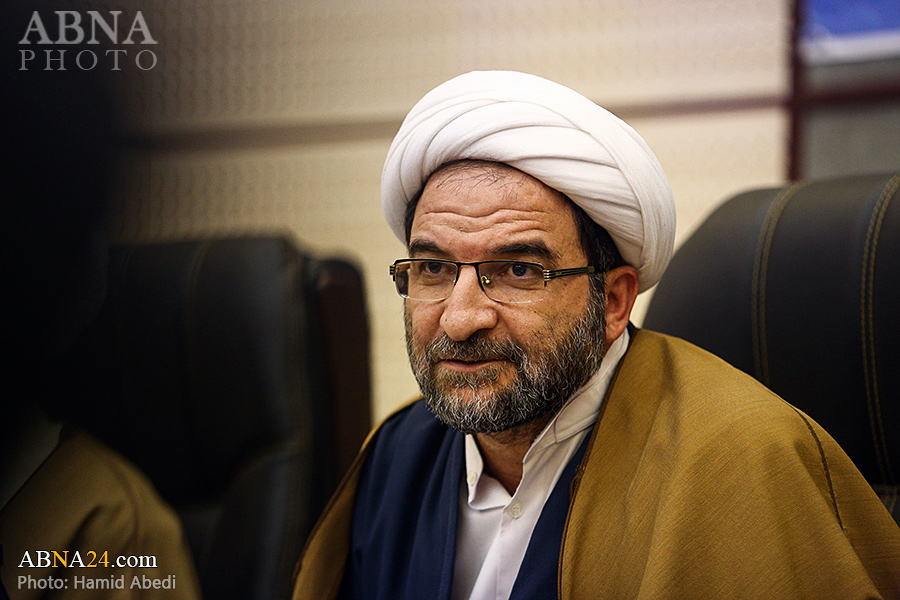AhlulBayt News Agency (ABNA): The seminar “Consolation Theology, the Study of the Nature, Wisdom, Legitimacy and Themes”, was held by the Faculty of Islamic and Modern Theology Research of the Institute for Islamic Culture and Thought in person and virtually.
Hojat al-Islam Mahdi Farmanian, Hojat al-Islam Habibullah Babaei, and Hojat al-Islam Mohammad Baqer Pouramini were the speakers at the seminar.
As the first speaker of the seminar, Hojat al-Islam Mahdi Farmanian, a faculty member of the University of Religions and Denominations, stated, “Sunnis, in general, consider mourning legitimate, though most Sunni jurists consider it permissible to mourn the deceased for up to three days. Of course, these jurists believe there is no problem in mourning if it is held for the Companions (of the Prophet), provided that Islamic teachings are expressed in the ceremony. However, Sufis have held mourning for Imam Hussain (a.s.) throughout history.”
Referring to mourning among Sunnis, he added, “Mr. Jafarian has written an article about the historical background of mourning among Sunnis, using important sources, one of which is a book by Abdul Jalil Qazvini. “Some Sunnis criticize us (Shiites) that mourning for Ashura is heresy!” he further continued in severe criticism, “Khwaja Bu Mansour (contemporaneous with the writer), one of the great Sunni scholars in Isfahan, has held mourning ceremonies (for Imam Hossein) every year”.”
“In Baghdad, Khwaja Ali Ghaznavi held mourning ceremonies (for Imam Hussain) and exaggerated in cursing the family of Abu Sufyan. In one of the ceremonies someone from the crowd asked, “What do you think about Muawiya?” He pretended not to hear the question twice, but when he saw the questioner’s insistence, he said, “I do not know! Which Muawiya do you mean? The same Muawiya whose father broke the tooth of the Prophet, and whose mother tore the liver of Hamzah (Prophet’s uncle), drew the sword on Ali more than 20 times, and his son beheaded the (Imam) Hussain? O Muslims! What do you think about this Muawiya?” In the continuation of the ceremony, people from different denominations cursed Muawiya,” he added.
The professor at the University of Religions and Denominations
stated, “He has even announced the holding of a mourning ceremony for Imam
Hussain (a.s.) in Baghdad every year. In Hamedan, Majduddin Hamedani held such mourning
ceremonies on the anniversary of Ashura, which even surprised the people of
Qom. Also, during the Timurid era, the Hanafi Sunnis of Khorasan mourned Imam
Hussain (a.s.) many times. Mullah Waez Kashefi, the author of the book “Rowzat
al-Shuhada” was expelled from Neishabur for being a Sunni and expelled from Herat
for being a Shiite! During the Timurid era until the rise of the Safavids,
several important events occured, such as the great development of the love for
the AhlulBayt (a.s.) and mourning for them, and many books were written by the
Twelver Sufis.”
Mourning for Imam Hussain (a.s.) in Medina
About the mourning ceremonies in Medina, Farmanian said, “Another issue is the mourning of the people of Medina. Waqidi, who died in 207 AH, reported in his book about mourning in Medina, “Now that I am living in the second and third centuries of Hijrah when the people of Medina lose a loved one, they first cry for Hamza, the uncle of the Prophet (p.b.u.h), which is a historical event. Because, when Hamza was martyred, no one cried at his for him and the Prophet (p.b.u.h) ordered, “weep for Hamza” and this has become a tradition”.”
The Deputy for Scientific and Cultural Affairs of the AhlulBayt (a.s.) World Assembly stated, “In the 5th Hijri century, the Hakem Neishaburi, also spoke about the mourning of the people of Medina. The people of Madinah were Sunnis during that period, and Madinah has never had a Shiite population throughout history. Therefore, mourning for Imam Hussain (a.s.) is a definite and legitimate issue, and it has lasted for three days, although mourning for more than three days is debatable.”
“During the Abbasid period, some regions mourned for Imam Hussain (a.s.), and throughout the Timurid period, this issue developed significantly, and in the 15th Hijri century, that is, today, (Sunni) Sufis in Pakistan and other regions also mourn for the Imam. Of course, they do not consider breast-beating and chain-beating permissible, and they only believe in holding meetings and expressing the sufferings of AhlulBayt (a.s.). Also, there is a difference between Sunni ulama regarding the low or loud crying. They, without hesitation, allow silent crying. While crying out loud is considered by some to be Makruh (abominable), some to be Mubah (neutral), and others to be Haram (forbidden),” Farmanian continued.
Mourning, a step to get to know the AhlulBayt (a.s.) teachings
“Among Shiites, mourning for Imam Hussain (a.s.) is the first step to know the AhlulBayt (a.s.) teachings in many regions,” he emphasized, “During the 6th, 7th, and... Hijri centuries, in East Asia, North Africa, and some other regions, there were missionaries who guided people towards Shiite teachings by mourning for Imam Hussain (a.s.). This can also be seen in some historical books of Christianity. This issue is a matter of Fitrah (human divine nature). Because defending the oppressed and sympathizing with him is part of human Fitrah. There may be something like this in other religions such as Buddhism and others. Therefore, mourning, if carried out correctly, can be a good introduction to propagating the AhlulBayt (a.s.) teachings throughout the world,” he said in the end.
**************
End/ 345

